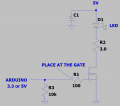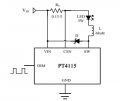Hi all.
So this post is basically a post where I need ur feedback to tell me if I made the right choice of an LED driver IC.
I purchased a RGBW led. I would like to control the brightness and color of this LED at its max voltage and current values; within an Arduino.
After a lot of digging around I came to the conclusion that the LM3464 is my best option. ( https://www.ti.com/product/LM3464 )
I would appreciate it if someone could tell me if I chose a 'good enough' driver IC based on the info I am giving you below.
The datasheet for the led is at https://www.ledsupply.com/content/pdf/XLampXML_Color.pdf
Below are the main characteristics of the led.

Here are my requirements:
1) I need to be able to control the brightness of each LED, with an Arduino; up to its full brightness! ( I feel this is possible cause this driver is rated for a max Vout of 80V and 4 Amps. )
2) I need to be able to control all 4 colors with an Arduino. ( I feel this is possible since this IC has 4 channels. )
It believe, that the LM3464 LED driver IC can output up to 80V and 4A per channel, which is sufficient to meet the forward voltage and current requirements of my RGBW LED. This allows me to drive each LED color at its maximum specified current.
The LM3464 has 4 channels, enabling individual control of each LED color using PWM signals from an Arduino. This means that I can adjust the brightness of each color independently.
I believe I need to dig up the proper current-limiting resistors which gotta go in series with each LED to limit the current to stop them from overdriving.
Can someone tell me if my choice of a driver will work out for me? Can someone tell me if I am making any major errors in my conclusions?
Ty!
So this post is basically a post where I need ur feedback to tell me if I made the right choice of an LED driver IC.
I purchased a RGBW led. I would like to control the brightness and color of this LED at its max voltage and current values; within an Arduino.
After a lot of digging around I came to the conclusion that the LM3464 is my best option. ( https://www.ti.com/product/LM3464 )
I would appreciate it if someone could tell me if I chose a 'good enough' driver IC based on the info I am giving you below.
The datasheet for the led is at https://www.ledsupply.com/content/pdf/XLampXML_Color.pdf
Below are the main characteristics of the led.

Here are my requirements:
1) I need to be able to control the brightness of each LED, with an Arduino; up to its full brightness! ( I feel this is possible cause this driver is rated for a max Vout of 80V and 4 Amps. )
2) I need to be able to control all 4 colors with an Arduino. ( I feel this is possible since this IC has 4 channels. )
It believe, that the LM3464 LED driver IC can output up to 80V and 4A per channel, which is sufficient to meet the forward voltage and current requirements of my RGBW LED. This allows me to drive each LED color at its maximum specified current.
The LM3464 has 4 channels, enabling individual control of each LED color using PWM signals from an Arduino. This means that I can adjust the brightness of each color independently.
I believe I need to dig up the proper current-limiting resistors which gotta go in series with each LED to limit the current to stop them from overdriving.
Can someone tell me if my choice of a driver will work out for me? Can someone tell me if I am making any major errors in my conclusions?
Ty!
Last edited:














